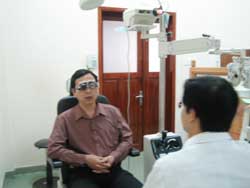By using a new type of artificial lens, patients with cataracts may not need to wear glasses after surgery.
 |
|
Before undergoing surgery to implant the Acrysof Restor accommodating lens, patients must have an eye and fundus examination as soon as possible. (Photo: H.Cát) |
One month after having the Acrysof Restor accommodating lens implanted in both eyes, 23 patients reported that they no longer needed glasses for daily activities and could see both near and far distances.
This result was announced by Dr. Tran Thi Phuong Thu, Director of Ho Chi Minh City Eye Hospital, during a press conference on June 15 before the 8th Ophthalmic Science and Technology Workshop.
Since late 2004, Ho Chi Minh City Eye Hospital has been testing the use of accommodating artificial lenses in its Semi-Public High-Tech Department. Approximately 200 surgeries have been performed to implant the Acrysof Restor accommodating lens, including 23 cases where the lens was implanted in both eyes.
While conventional artificial lenses allow wearers to see either far or near, the Restor lens can adjust for both near and far vision. Therefore, it offers patients a wide range of vision for near, intermediate, and far distances, significantly reducing or eliminating the need for corrective glasses post-surgery.
|
The lens is a transparent disc located inside the eye, focusing light rays onto the retina to create sharp, clear images, similar to how a camera lens focuses images onto film. The lens functions as a converging lens located behind the iris and plays a role in the eye’s focusing process. Cataracts occur when the lens becomes cloudy. A cloudy lens is similar to a fogged glass that obscures the view outside. This clouding prevents light from passing through, resulting in a failure of the retina to capture images and a decline in the patient’s vision, potentially leading to blindness. The main causes are related to aging, diabetes, high blood pressure, myopia, and trauma. Over 80% of people with cataracts are over the age of 50. Additionally, there are other causes such as ultraviolet and infrared rays from sunlight. Symptoms of cataracts include: 1. Blurred vision, decreased visual acuity, difficulty seeing, glare, night blindness, and worse vision in bright sunlight compared to shaded areas. 2. Poor vision in bright surrounding areas. 3. Seeing one object as two or three; and frequently changing glasses. (Source: medinet.hochiminhcity.gov.vn) |
According to research by the U.S. Food and Drug Administration (FDA), 80% of patients who receive this accommodating artificial lens do not need glasses for distance or near vision. Currently, this result has improved, with over 90% of patients post-surgery not requiring supplemental glasses.
In contrast, after receiving a conventional artificial lens, only about 20% of patients do not need glasses.
The best candidates for this accommodating artificial lens are patients who only have cataracts and no other eye diseases.
Therefore, Dr. Phuong Thu emphasizes that to achieve the best surgical results, patients should come for early examinations so that the doctor can check the fundus and rule out other eye conditions.
However, many cataract patients visiting Ho Chi Minh City Eye Hospital are primarily in advanced stages. The cloudy and opaque eye makes it difficult for doctors to predict other eye conditions due to the inability to examine the fundus.
Currently, in the Semi-Public High-Tech Department of Ho Chi Minh City Eye Hospital, the cost for one accommodating artificial lens is $1,000 per eye, whereas in the U.S., the cost ranges from $4,000 to $5,000.
Ho Chi Minh City Eye Hospital is still monitoring long-term results over the next 2-3 years and has not yet widely introduced this accommodating artificial lens treatment to patients.
In the future, the use of accommodating artificial lenses may replace refractive surgery and could be directed towards surgery for presbyopic patients, even those with early-stage cataracts.
According to statistics from Orbis, cataracts are the leading cause of blindness, accounting for 65% of blindness causes in Vietnam.
Huong Cat

















































